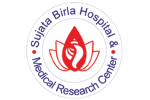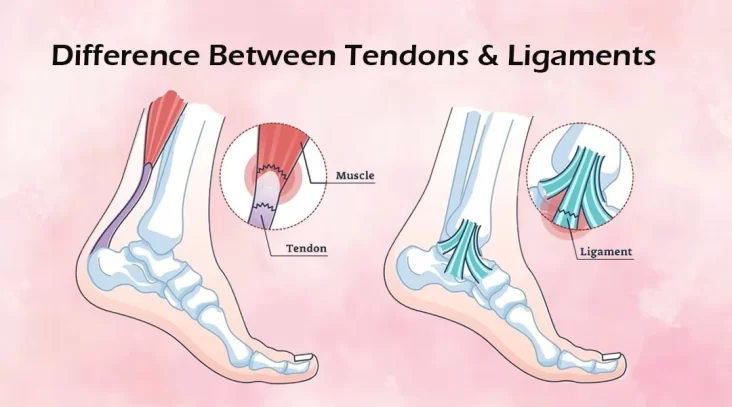Ligaments and tendons are both formed of fibrous connective tissue, but that’s about where the similarities end.
Ligaments are cross-like bands that support joints and link bones. For instance, the anterior cruciate ligament (ACL), which stabilises the knee joint, connects the thighbone to the shinbone.
Tendon, which is situated at either end of a muscle, connects muscle to bone. Tendons cover the majority of the body, including the head, neck, feet, and the rest. The largest tendon in the body is the Achilles tendon. It connects the calf muscle and heel bone. Your shoulder’s ability to move forward and backwards is helped by the rotator cuff tendons.
Continue reading to find out more about the difference between tendons and ligaments.
How do ligaments and tendons work?
With a network of strong, interlaced threads that hold bones together, ligaments can be compared to rope. Ligaments include elastic fibres as well, but not enough to allow the joint to move past its limits.
For instance, the knee joint has four main ligaments, two of which span the front and back of the kneecap diagonally. These ligaments aid in stabilising the knee and prevent excessive forward, backward, or side-to-side motion.
They do, however, have a little greater flexibility than ligaments. Tendons are likewise tough cords. The linked tendon pulls the bone into movement as the muscle contracts. Consider how your bicep reacts as you bend. Imagine how your bicep feels as you bend your elbow. Tendons also assist in absorbing some of the force exerted by muscles as they contract.
What are the most common ligament and tendon injuries?
Ligament
Sprain is the medical term for when a ligament is stretched too far or torn. Sprains frequently occur unexpectedly as a result of a fall, uncomfortable movement, or blow.
Sprains frequently affect the wrist, ankle, or knee. For instance, a slip-up can force you to twist your ankle awkwardly, rupturing a ligament and making your ankle flimsy or unstable. When the injury happens, you might hear a pop or experience a rip. When you reach out with your outstretched hand to break a fall, the wrist often hyperextends back, resulting in a sprained wrist. The ligament was overextended during that hyperextension.
In general, pain, oedema, and bruising in the affected area are signs of a damaged ligament. The joint could feel weak or flimsy and be incapable of supporting weight. Whether the ligament is overextended or truly torn will affect how severe your symptoms are.
Sprains are categorised by severity by doctors, ranging from grade 1 (a moderate sprain with minor ligament straining) to grade 3 (a complete tear of the ligament causing instability in the joint).
Tendon
A strain occurs when a tendon is overextended or ruptured. Leg, foot, and back strains are frequently felt in these locations.
Athletic activity and repetitive motion frequently result in strains. Athletes who overtrain their bodies without giving their muscles enough time to recover between workouts run a higher risk of injury.
Pain and swelling are common symptoms, just like a sprain. You might also feel weak and your muscles might cramp.
What’s tendonitis?
Another type of tendon injury is tendonitis, which is an inflammation of the tendon. This could happen as a result of ageing naturally. Tendons deteriorate with age, just like other body parts, making them more vulnerable to strain and injury.
Overusing a tendon can also result in tendonitis. For example, tendinitis in the shoulders is common among pitchers in baseball and golf.
Pain when the muscle is manipulated and oedema are signs of tendonitis. To the touch, the affected muscle could feel heated.
How to treat tendon and ligament injuries
It can be challenging to determine whether you have a ligament or tendon injury on your own. If you have pain or swelling, see your doctor for a specific diagnosis and a practical treatment plan.
However, the immediate course of therapy is typically the same whether the injury is a sprain or a strain. Doctors advise:
- Rest. Until full healing has begun, try to keep your wounded body part immobile. If necessary, crutches and immobilisation braces may make this process simpler.
- Ice. As you heal, apply ice to the damaged area for 20 minutes at a time, multiple times each day, while wrapping ice in a towel to protect the skin.
- Compression. Use a compression bandage to lessen swelling. Make sure the bandage is tightly cinched without becoming excruciatingly so.
- Elevation. If you keep your injured body part elevated above your heart, it will heal more quickly.
- Medication. You may experience reduced soreness and swelling if you use over-the-counter painkillers and anti-inflammatories as needed.
Preventing sprains and strains
Some injuries, such as a jolt to the knee from a car accident or a sudden stumble, cannot always be avoided. But some are not. Follow these guidelines to safeguard your tendons and ligaments:
- Warm up before exercising. Spend around 10 minutes warming up your body with easy aerobic exercises before you begin exercising. For instance, take a few laps to stroll before running around the track.
- Start out slowly and build gradually. Your muscles will warm up as a result of this.
- Wear shoes that fit properly and are appropriate for the sport.
- Maintain a healthy weight.
- Vary your routine. Get the right combination of aerobic and strength training.
- After a rigorous workout, take the day off or at the very least move to a different activity. You may be less likely to overstress the same ligaments and tendons as a result.
- Listen to your body. Rest if you’re uncomfortable or worn out. When your body is already exhausted or stressed, many injuries occur.
- Stretch. After exercise, when your body is warm and more malleable, the majority of specialists advise stretching. Stretch only once, holding each stretch for no longer than 10 to 20 seconds. Never bounce or strain yourself till it hurts.
The outlook
The body has tens of thousands of ligaments and tendons. Although both tendons and ligaments are composed of connective tissue and both can be stretched or damaged, there is a significant difference between tendons and ligaments.
One bone is connected to another by ligaments. Muscles and bones are connected by tendons. But both are necessary for good body mechanics. The key to living an active and pain-free life is spotting ligament and tendon issues early on before they develop into serious injuries.


One Comment
Pingback: Difference between tendons and ligaments – Sujata Birla Hospital